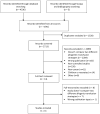How low should we go: A systematic review and meta-analysis of the impact of restrictive red blood cell transfusion strategies in oncology
- PMID: 27046422
- PMCID: PMC4884540
- DOI: 10.1016/j.ctrv.2016.03.010
How low should we go: A systematic review and meta-analysis of the impact of restrictive red blood cell transfusion strategies in oncology
Abstract
Background: Most non-oncologic clinical practice guidelines recommend restrictive allogeneic blood transfusion practices; however, there is a lack of consensus regarding the best transfusion practice in oncology. We conducted a systematic review of the literature to compare the efficacy and safety of restrictive versus liberal transfusion strategies in patients with cancer.
Methods: A literature search using MEDLINE, PUBMED and EMBASE identified all controlled studies comparing the use of restrictive with liberal transfusion in adult oncology participants up to August 10, 2015. Two review authors independently assessed studies for inclusion, extracted data and appraised the quality of the included studies. The primary outcomes of interest were blood utilization and all-cause mortality.
Results: Out of 4241 citations, six studies (3 randomized and 3 non-randomized) involving a total of 983 patients were included in the final review. The clinical context of the studies varied with 3 chemotherapy and 3 surgical studies. The overall risk of bias in all studies was moderate to high. Restrictive transfusion strategies were associated with a 36% reduced risk of receiving a perioperative transfusion (risk ratio (RR) 0.64, 95% confidence interval (CI) 0.49-0.83). There was no difference in mortality between the strategies (RR 1.00, 95% CI 0.32-3.18). There were no differences in adverse events reported between the restrictive and liberal transfusion strategies.
Conclusion: Restrictive strategy appears to decrease blood utilization without increasing morbidity or mortality in oncology. This review is limited by a paucity of high quality studies on this topic. Better designed studies are warranted.
Keywords: Anemia; Blood; Cancer; Neoplasms; Systematic review; Transfusion.
Copyright © 2016 Elsevier Ltd. All rights reserved.
Figures



References
-
- Foubert J. New EORTC guidelines for the treatment of anaemia in patients with cancer: Implications for nursing practice. Eur J Oncol Nurs. 2006;10:177–86. - PubMed
-
- Ludwig H, Van Belle S, Barrett-Lee P, Birgegard G, Bokemeyer C, Gascon P, et al. The European Cancer Anaemia Survey (ECAS): a large, multinational, prospective survey defining the prevalence, incidence, and treatment of anaemia in cancer patients. Eur J Cancer. 2004;40:2293–306. - PubMed
-
- Knight K, Wade S, Balducci L. Prevalence and outcomes of anemia in cancer: a systematic review of the literature. Am J Med. 2004;116(Suppl 7A):11S–26S. - PubMed
-
- Spivak JL. Cancer-related anemia: its causes and characteristics. Semin Oncol. 1994;21:3–8. - PubMed
-
- Altman AD, Liu XQ, Nelson G, Chu P, Nation J, Ghatage P. The effects of anemia and blood transfusion on patients with stage III–IV ovarian cancer. Int J Gynecol Cancer. 2013;23:1569–76. - PubMed
Publication types
MeSH terms
Grants and funding
LinkOut - more resources
Full Text Sources
Other Literature Sources

